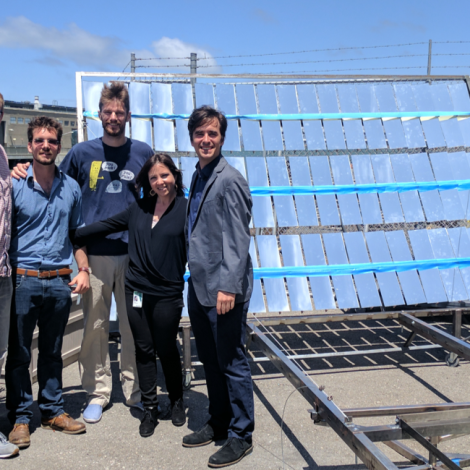Editor’s note: Demand: ASME Global Development Review shuttered after six years of publishing coverage of the most interesting manifestations of design, engineering and social ventures in global development. The biannual magazine was a premier source of global development writing and a sister publication to Engineering for Change. As an homage to Demand and the work of the experts whose voices it disseminated, we are reprinting Demand’s articles and images on this site.
How the products we use and buildings we inhabit are designed plays an instrumental role in climate change.
In 2015, the international community made a commitment to protect our collective future by ensuring that global temperatures do not rise more than two degrees Celsius. U.N. Environment’s latest Emissions Gap report estimates that it is “extremely unlikely” that that can be achieved if global carbon emissions don’t peak in 2020 and states don’t meet their individual emission reduction targets by 2030. “Industry and the financial community can and must collaborate to provide the conditions that foster and fast-track innovative solutions,” the report states. “This is the only way to keep the global temperature rise below 1.5 degrees and reduce the human and economic cost of pollution.”
Joe Speicher, executive director of Autodesk Foundation, and Chad Frischmann, research director at Project Drawdown, talk to Demand about the role of design thinking and tools in enabling climate friendly technological innovation.
Demand: Chad, your organization, Project Drawdown, has identified 80 solutions that can have a material impact on climate change as well as 20 promising ideas. But “impact” in climate change is often framed in big numbers that can be very hard to relate to on an everyday level. How do you communicate the concept of impact in your work?
Frischmann: I have trouble explaining to people what the scope of a “gigaton” is. But numbers are valuable because they allow us to rank. I don’t love that term — rank — but it gives us an estimation of what is most impactful. Numbers allow us to quantify how these things all relate to one another.
To really inspire people, numbers are helpful, but it’s really communicating that into action and getting rid of the discourse of fear and empowering people to do things at all levels of society. We need businesses, households, governments and farmers to all take action. The whole fabric of society needs to be involved.
Demand: Joe, how does a software company like Autodesk identify its role in taking action on climate change?
Speicher: When most companies talk about sustainability as a corporate initiative, it’s generally seen as a cost center. Ours is about helping customers be more sustainable in how they design and make things.
Autodesk tools are the primary tools for the built environment and for designing products that we use in the world. For all intents and purposes, we’re an automation company, helping designers automate their decisions around geometry. So how are we at Autodesk going to be good global citizens? It’s not supporting orphanages or reforming healthcare. If we want to have an impact as a company, helping our customers design and make products that reduce emissions a prepare for a warmer planet is the best use of our resources.
The opportunity to influence the tools that are used in design is huge. We’re able to [help] automate decisions that align with sustainability — how to pick better materials, design buildings to be more energy efficient, etc. It’s the single biggest leverage point that we have in terms of impact.
Solutions to Reverse Global Warming: Joe Speicher and Chad Frischmann present this E4C Webinar.
Demand: Where could sustainable design thinking have the biggest impact on climate change mitigation and/or adaptation?
Frischmann: The top one is a material: refrigerants. Most refrigerants are made from hydrofluorocarbons (HFCs). HFCs’ global warming potential is 1,000-times greater than carbon dioxide.
In terms of impact, what we have looked at is management of HFC leakage. The big problem is when appliances get discarded, and the HFCs leak in a landfill. There are management practices out there, like destroying HFCs at the end of life (through incineration, for example), but not enough.
The other thing to consider is to reduce or phase out HFCs altogether, like we did with chlorofluorocarbons. If you phased out HFCs, you could get rid of 160-gigatons of C02 equivalent. The Kigali Accord in 2016 outlines a framework for phasing out the production of HFCs in high, middle, and low-income countries, and replacing them with alternatives like ammonium and carbon dioxide.
Demand: To reduce climate impact, we would need to use more carbon?
Frischmann: Carbon dioxide in this case would actually be better because the quantity required for refrigeration would be quite low. There’s also a natural cycle for carbon, and it has lower global warming potential than HFCs. Carbon can also be absorbed in plants, whereas HFCs stay in the atmosphere for hundreds of years. We can even destroy CO2 in the ground before it gets to the atmosphere.
Demand: What kind of progress are we making on phasing out HFCs?
Frischmann: It’s about investing in innovative alternative technologies. There are an increasing number of alternative sources of natural refrigerants coming on the market. And there are very few HFC producers, so there is a lot of room in the market for bottom-up alternatives. One that’s interesting is a research program that is looking at nanofilm that can cover fresh produce. It preserves the lifetime of produce without ever have to use a refrigerator and washes off easily.
Demand: To what extent to we need to create new climate-friendly technology versus drive adoption of existing technology?
Frischmann: There’s a lot of room for innovation in proven technologies as well as new ones. Innovation allows us to test the waters and ultimately get to the “next generation.” Think about third and fourth generation solar panels. By improving the capacities that allow them to be more efficient and take up less space, we use fewer materials and reduce costs for consumers. That drives adoption, and those solar panels become part of a system that feeds into the distribution of energy and the power grid, and that drives greater renewable energy adoption. It allows populations to eventually start thinking about how the individual action of installing a rooftop solar panel feeds into an entire system.
Demand: There are plenty of existing technologies where there is demonstrated impact but adoption is still a challenge. That’s because the question of adoption deals with more than cost and materials. There are cultural factors as well, which also have to be considered in product design.
Speicher: Two examples come to mind for me. The first is BioLite [which is] taking a proprietary technology and putting it in a new context. They’ve taken Autodesk’s tools and optimized the efficiency and design of cookstoves. They have also built a brilliant business model.
The reason BioLite’s cookstoves have a cell phone charging feature is because in order to sell cookstoves in developing countries, you have to convince the male head of the household [to buy it]. In East Africa, you can buy cheap cookstoves. There are alternative products [to BioLite’s] on the market for half to one fifth of the price. Why should a man decide to invest in a high efficiency stove when there’s no real value proposition to the man? Get it to do something that the man is interested in. It opens up a new marketing channel.
The second is Build Change [which is] working with homeowners to build more earthquake-resilient structures. After an earthquake, people typically rebuild the same way things were built before. Build Change works with local labor forces in developing countries to rebuild with more resilient structures, then leaves [communities] with the updated codes and how to enforce those codes. They are increasingly focused on [other types of] natural disasters. Given the way the 2017 Atlantic hurricane season devastated southern U.S. and island communities, it’s clear that investing in a future that will reduce the need for disaster relief is absolutely key.
Demand: The U.N. and a number of other organizations have noted the role of the financial community in supporting climate change mitigation and adaptation. A 2017 report from Climate Policy Initiative noted that the hundreds of billions of dollars in “climate finance” invested every year “remains far below estimates of what is needed.” How do organizations like Project Drawdown and Autodesk Foundation help to ensure that limited capital resources get invested in the most promising technologies?
Speicher: We work with PRIME Coalition, a financial intermediary that has now become an investor in climate solutions. PRIME is seeding the market for significant opportunities in energy generation, distribution and usage. Its requirement for investees is that they demonstrate potential to reduce carbon emissions by a gigaton. It’s ambitious, but it also addresses the problem at scale.
PRIME is a nonprofit, so we have provided them with grant funding to support their operations and in certain cases, we’ll provide value added services to the organizations they support that have made it through their investment committee screening. For example, we are providing a fab lab for prototyping to the PRIME cohort.
Frischmann: At Drawdown, we try to aggregate all of the data and research out there and present it to different audiences in an accessible way. We need to devise more shared lessons and learnings and have a reinforcing feedback loop.
We actually have a good feedback loop: it’s the earth. The earth is giving us feedback about what we’re doing through climate change and global warming. We have to learn from that and be willing to accept it and share.

